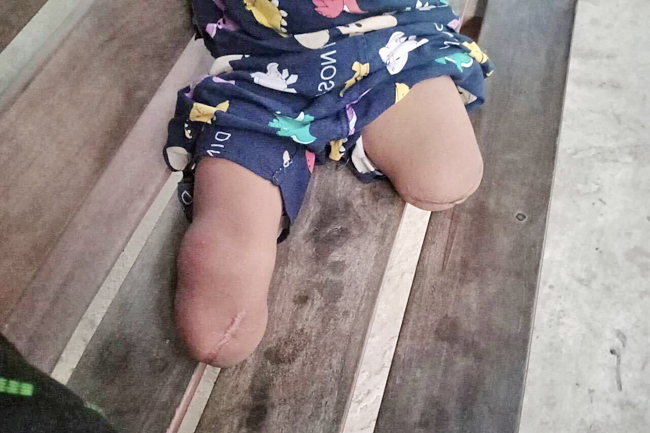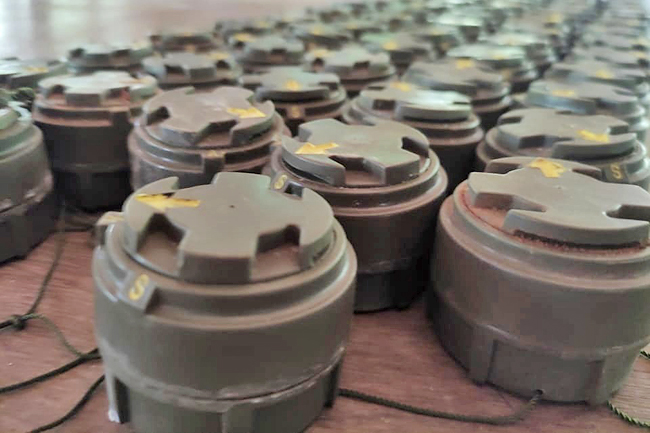BANGKOK (AP) – The three-year-old boy had taken only two steps from his mother’s lap when a deafening explosion rang out. The blast caught the woman in the face, blurring her vision.
She forced her eyes open and searched for her son around the busy jetty where they’d been waiting for a ferry, near their small village in south-central Myanmar.
Through the smoke, she spotted him. His small body lay on the ground, his feet and legs mangled with flesh peeled away, shattered bones exposed.
“He was crying and telling me that it hurt so much,” she said. “He didn’t know what just happened.” But she did.
The woman’s son had detonated a landmine, an explosive device designed to mutilate or destroy whatever comes into its path.
Landmines have been banned for decades by most countries, since the United Nations (UN) Mine Ban Treaty was adopted in 1997. But in Myanmar, which is not party to the treaty, the use of mines has soared since the military seized power from the democratically elected government in February 2021 and armed resistance has skyrocketed.
Landmines are planted by all sides of the bloody conflict in Myanmar, and they’re responsible for surging civilian casualties, including an alarming number of children as victims, according to an AP analysis based on data and reports from nonprofit and humanitarian organisations, interviews with civilian victims, families, local aid workers, military defectors and monitoring groups.




In 2022, figures from the UN show, civilian casualties from landmine and unexploded ordnance spiked by nearly 40 per cent. Experts say this and other official tallies are vastly undercounted, largely due to difficulties monitoring and reporting during the conflict.
Despite incomplete numbers, experts agree that the increase in Myanmar is the largest ever recorded. Virtually no area is immune to the threat. Over the past two years, mine contamination has spread to every state and region except for the capital city, Naypyitaw, according to Landmine Monitor, a group that tracks global landmine use.
The military also uses civilians as human shields, a practice widespread in the country for decades but raising alarms with increasing mine incidents. AP’s analysis found the military, known as the Tatmadaw, forced people to walk ahead of troops to detonate potential landmines in their path, protecting their own troops.
According to local and international human rights groups, the Tatmadaw has mined homes, villages, walking paths, church compounds, farms, mobile phone towers and a Chinese-backed oil and gas pipeline and copper mine.
The Myanmar military, which has acknowledged mine use in the past, did not respond to a list of questions AP sent to their official spokesperson’s email.
Even when the fighting moves on, the landmines don’t. The mines left behind can indiscriminately maim or kill those who happen upon them for years after hostilities have ended.
It raises the specter of casualties for years to come. In countries including Egypt and Cambodia, people continue to die from millions of mines left behind long after conflicts has ended.
“Leaving an activated mine like this is the same as releasing a monster,” said a 26-year-old military defector who worked as a combat engineer platoon commander in Myanmar. “Mines don’t have friends or enemies. Even a gun only shoots in the direction it’s pointed.”
Like most who were interviewed by AP, the defector spoke on condition of anonymity to protect himself and his family from military retaliation. Many in Myanmar who speak with reporters can face detainment or violence.
Landmines and unexploded ordnance have been a persistent issue in Myanmar for more than four decades. The problem has grown exponentially since the military takeover, with heavier use of landmines in more parts of the country, said UN landmine specialist Kim Warren, who’s monitored issues in Myanmar.
In 2022, 390 people were victims of landmines and unexploded ordnance in Myanmar, more than a 37 per cent increase from 2021, according to figures compiled by UNICEF. Overall, 102 people were killed and 288 were wounded, with children making up some 34 per cent of the victims, compared with 26 per cent in 2021.
Still, Warren said, incidents are underreported. She cited the lack of a robust information management system, the sensitivities around reporting conflict-related data, and difficulties getting care for victims.
Landmine Monitor’s Myanmar expert Yeshua Moser-Puangsuwan said his group counts only casualties it can confirm with confidence.
“We’ve always been undercounting,” he said. “How many more? Double? Almost certainly. Triple? Could be.”
Experts concede the total number of casualties may seem small, with Myanmar’s population of about 56 million, but say the rapid increase is distressing nonetheless, given the underreported cases, the destructive nature of mines and their use amid the decades-long conflict.
Experts are particularly concerned about children victims, like the boy who triggered the mine at the jetty. Many are unaware of how lethal landmines and unexploded munitions are; some pick them up and play with them.
Most children are no longer in school amid the conflict, leading to more unsupervised time. Violence has also forced more than 1.2 million people from their homes, according to the UN, so children and others frequently move around in unfamiliar areas.
Many civilian victims encounter landmines during daily routines – just going about their days until life changes forever.
In March 2021, two teenage cousins were working on a small family-run plot in Shan state.
They had just left to dig for sweet potatoes when the father of one of the boys heard a blast from his home. He rushed to help, but he was too late. They’d been killed instantly. They’d triggered a mine.
The father, 47, teared up when he returned to the fields, where he found tattered clothes and mangled bodies.
“But it’s my family’s business, so I have to come to the farm to make a living,” said the man, who spoke on condition of anonymity to protect himself and his relatives.
On the other side of the country, in western Chin state, a 20-year-old farmer was returning home from weeding a rice paddy field on a sunny May day when he triggered a mine buried on a path he’d walked many times before.
“The explosion engulfed me, and my entire surroundings were clouded in smoke. I thought I was dying,” he told AP on condition of anonymity, out of fear for his safety.
“I could see bones. The right leg was completely destroyed up to the ankle. My whole body was hot as if it was on fire and my skin was black.”
During his 18-day stay in the hospital, his right leg was amputated about four inches below the knee.
Many victims and families won’t know who was responsible for the blasts – the Tatmadaw or anti-military groups – as all sides of the conflict use mines.
A member of a militia that operates in Sagaing said his group has removed nearly 100 mines thought to be planted by the military and plans to reuse them to augment its arsenal of homemade devices.
“A mine is an indispensable weapon to attack the enemy,” said the member, who spoke by phone.
It’s a common practice: Militias and armed groups announcing they’ve demined areas where they operate, only to reuse the weapons.
“They just move the mines to a new location,” Moser-Puangsuwan said. “And that is not what we call demining.”





